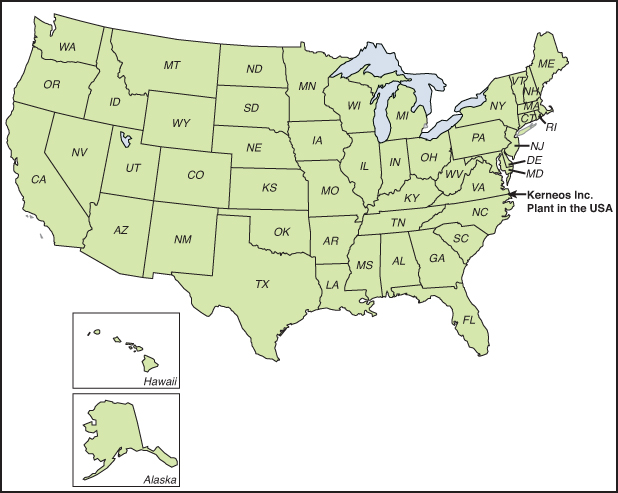Case 11. Supplier Selection at Kerneos, Inc.
† Old Dominion University, Norfolk, Virginia, USA; [email protected]
‡ Old Dominion University, Norfolk, Virginia, USA; [email protected]
* Kerneos, Inc., Chesapeake, Virginia, USA; [email protected]
Introduction
Kerneos, Inc. is the Kerneos SA subsidiary in the United States. Although headquartered in Paris, France, Kerneos SA has six manufacturing plants, one in the United States, two in the UK, two in France, and one in China. Its manufacturing facilities produce a wide range of cements based on alumina content. The lower alumina content cements, such as Fondu and Secar 41, are produced in a fusion process at two plants located in France: Dunkirk and Marseille. The higher alumina content cements, such as Secar 71 and Secar 80, are produced via a sintering process at plants in France, China, the UK, and the U.S.
Located in Chesapeake, Virginia, Kerneos, Inc. produces both high- and low-range calcium aluminate cements (see Exhibit 11-1). The high-range cements are produced in a sintering kiln located on the plant premises, while the low-range cements are produced by grinding low-range cement clinkers that are received from sister plants in France. The Chesapeake plant is capable of producing approximately 30,000 tons of high-range cements through the kiln process and 70,000 tons of low-range cements through the grinding process. Kerneos, Inc. supplies cements to customers throughout the Americas, including the U.S., Canada, Mexico, and Brazil. Customers are supplied by either direct shipment from the plant or through a network of remote distribution centers.
In the past, Kerneos’ supply chain strategy was largely based on a push approach; i.e., the plant was supplied with as much raw material as possible, and then the final products were pushed into the distribution network without consideration of demand. The plant would operate until all of the outside warehouses and onsite storage capacity was filled and would then shut down. The plant would remain closed until inventory levels dictated the need to restart. Recently, the company modified its supply chain strategy through two measures: (i) introducing new IT tools to better enable distribution and sales demand to link with production planning, and (ii) putting more emphasis on working capital.
Upstream Supply Chain for High-Range Cements
In order to manufacture the high-range cements, Kerneos has to procure various raw materials. These raw material needs include metallurgical grade alumina, and quicklime, along with other raw materials. The procurement of the alumina is centrally handled by the Purchasing department at the corporate office in Paris. This is done to leverage the alumina requirements of all of the sintering plants within the company. Contracts are negotiated with the major alumina suppliers throughout the world, and Kerneos, Inc. has input as to the suppliers’ annual requirements. The alumina is shipped in a bulk vessel and the material is transported to Elizabeth River Terminals (a subsidiary of Kinder Morgan) located in Chesapeake, Virginia. The material is unloaded into bulk tank trunks, and trucks haul the material to the Kerneos site 1.5 miles away (see Exhibit 11-1). The alumina is then blown into a silo in preparation for the sintering process.
The Procurement of Quicklime
The procurement of the quicklime is handled and purchased locally by the Purchasing Manager at Kerneos, Inc. The Purchasing Manager receives input from the Production Manager regarding the quantity of quicklime needed for its annual production. The Purchasing Manager then negotiates contracts with at least two suppliers to ensure adequate supplies. The quicklime is trucked to the plant in bulk trucks and pumped off into a silo in preparation for the sintering process. Other raw materials arrive in bulk railcars, and are then pumped into silos.
The company uses a list of four major criteria to evaluate suppliers each year: quality, delivery, service, and price. The detailed sub-criteria appear in Table 11-1. At the end of each year, the Purchasing Manager forms a committee of five people to evaluate the three vendors with which Kerneos, Inc. contracted in the past year. Based on the ratings, the Purchasing Manager decides which suppliers should be offered a new contract and which ones should be replaced. The Purchasing Manager has collected three ratings for each vendor, using the rating criteria listed in Table 11-1. A total of nine surveys for the past year have been collected and are presented in Table 11-2. The Purchasing Manager would like you to compute the average score, the weighted score, and the total weighted score for each vendor.
Table 11-1. Supplier Evaluation Criteria
Table 11-2. Supplier Survey Data
2. Describe and graph the purchasing process at Kerneos, Inc.
3. Of the three vendors that Kerneos, Inc. currently uses, which vendor performed best? Which vendor should be replaced? Your recommendation should be supported by the average score, the weighted score, and the total weighted score of each vendor.
4. Are there any additional measures that you think should be considered in the decision process to keep or replace the current three vendors (other than the current scoring items)? Your suggestion(s) should be based on (a) the nature of the product, (b) the market and the supply chain structure of Kerneos, Inc., and (c) the supplier-buyer relationship management involved in supply chains.



